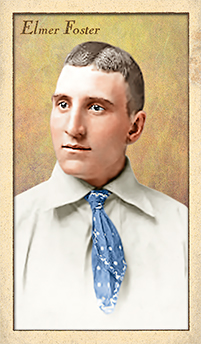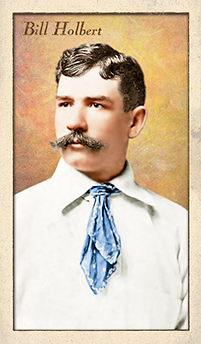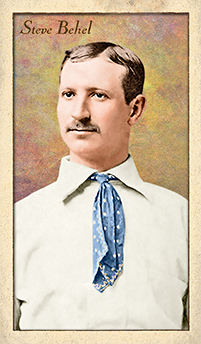
- Series: 1880s: Spotted Ties
- City: New York
- Team: Metropolitans
- League: American Association
Stephen Arnold Douglas Behel (1860-1945) had a life that spanned a remarkable period, from the eve of the Civil War to nearly the end of World War II. He only spent a few years out of those nine decades in professional baseball, but he could tell his grandchildren about how he was once a big league player.
Behel saw action in nine games in 1884 for the Milwaukee Brewers of the upstart Union Association, which had poached players from the dominant National League, the American Association and minor league teams. The UA managed to limp through that one season at the pinnacle of the game, though many decry the notion that it was truly a major league. The Brewers only played a dozen games in '84 as a replacement franchise late in the season along with the St. Paul Saints. The Saints never got to play a home game and the Brewers (aka Cream Citys) played only one on the road. Steve went 8 for 33, good for a .242 average which was third on the team.
Behel was a part-timer for the AA's NY Metropolitans in 1886, playing in 59 games, but his average slipped to .205. Primarily a minor leaguer, Behel began with the Fort Wayne Hoosiers of the Northwestern League in 1883 and concluded with Rockford of the Central Interstate League in 1888. His best season was with Eau Claire, where he batted .348 in 1887.
- The Earlville, IL native played most of his pro ball close to home, but he did get further afield with the Augusta Browns of the Southern League in 1885
Auction History
Cartophilia
Old Judge Pose: 26-1
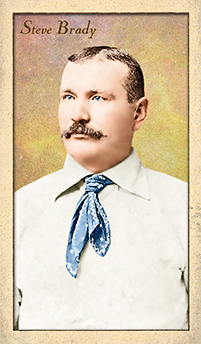
- Series: 1880s: Spotted Ties
- City: New York
- Team: Metropolitans
- League: American Association
Stephen A. Brady (1851-1917) was born in Worcester, MA and began playing professional ball in New England in the early days of the sport's arrival on the national scene. Brady started out with the Hartford Dark Blues of the pre-modern majors - the National Association of Professional Base Ball Players. The NAPBBP had become the first openly pro league in 1871 and Steve joined the fraternity the same year the Hartfords did, 1874.
Seven eastern seaboard clubs plus Chicago made up the circuit that year. Owned and organized by Morgan Bulkeley and anchored by the likes of Cherokee Fisher, Bob Addy, Orator Shafer and Lip Pike, Hartford’s Dark Blues disappointed and dwelt near the cellar in 1874, finishing with a 16-37 record as the Boston Red Stockings continued their dominance. Rookie Brady did well in a utility role however, contributing a .314 average in 27 games to an otherwise dismal season.
Brady would play only one game for the Dark Blues in 1875 before being shipped off to the Washington Nationals. The move was likely regrettable for him professionally. The Nationals would go 5-23 and bankrupt while his former Dark Blues dominated at 54-28 on the strength of contributions from a few newly acquired superstars. Tommy Bond and Candy Cummings won those 54 games with a combined ERA of 1.56 while the team, including recently acquired sluggers Black Jack Burdock and Tom York, flourished under the leadership and defensive wizardry of new player/manager Bob “Death to Flying Things” Ferguson.
Meanwhile, Brady’s performance in Washington mirrored his team’s: he floundered with a .143 batting average for a club that produced a .179 winning percentage. The minors soon beckoned and Steve played for NY and MA clubs, including the Metropolitans whom he joined for the 1881 season in the Eastern Championship Association. The team moved to the League Alliance and, in '83, ascended to the American Association, returning Brady to the majors through 1886. Moved to the outfield in '84, Steve's offensive production stabilized and he batted .264 over his tenure in NY. By 1887 Brady's old Hartford team was now in the Eastern League when he rejoined them for a very successful season, hitting .350.
- Per Wikipedia: Brady’s 1875 Washington Nationals "went out of business in St. Louis, Missouri, after playing the local Red Stockings on July 3 and July 4. Next day the players announced by telegraph that a club official had absconded with the funds but (Ryczek 1992: 194) concludes that "the tale had been planted by the players in an effort to find enough good samaritans to foot the bill for the trip home." The club probably failed by "unappealing play" and consequent receipts too small to support travel. On the final trip, they lost two in Philadelphia and five of six in St. Louis. The final game was a 12-5 victory but the two local teams outscored Washington 42-5 in the first five games, which must have been repelling."
Auction History
Cartophilia
Old Judge Pose: 39-1
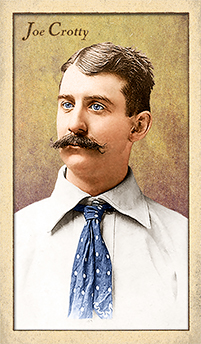
- Series: 1880s: Spotted Ties
- City: New York
- Team: Metropolitans
- League: American Association
Joseph P. Crotty (1860-1926) was a catcher in two leagues: the American and Union Associations. He was in these organizations with 4 clubs from 1882 to 1886. Before, during and after these years in the “major leagues,” Crotty floated among numerous minor league franchises including the Sioux City Corn Huskers in whose uniform he appeared in the Old Judge series for 1889. A journeyman receiver, Crotty had a typically anemic batting average (.170 in MLB) but fared 100 points higher when in the lower echelons. His career did allow him to see the country: as far east as Syracuse, south to Jackson and west to Helena. Joe’s initial year, 1882, was also a year of firsts for his two clubs. He began in Louisville with the new Eclipse squad and then was picked up by Chris von der Ahe’s St. Louis Brown Stockings. This enabled him to be present at the creation of the Cardinals as the controversial owner brought the team into the American Association.
- Joe’s other ML clubs were the Cincinnati Outlaw Reds and the NY Metropolitans
- The Reds played in the UA’s only season, 1884, affording Crotty another chance to make a kind of history
Auction History
Cartophilia
Old Judge Pose: 102-1

- Series: 1880s: Spotted Ties
- City: New York
- Team: Metropolitans
- League: American Association
Edgar Leander Cushman (1852-1915) was a left-handed pitcher with a less-than-stellar career record of 62-80 despite a sub-4.00 ERA. He was at times brilliant, as witnessed by his performance in his second year in the majors. Cushman had gotten into a handful of games for the Buffalo Bisons in 1883 and returned to the “big leagues” at the end of the '84 season with the Union Association's Milwaukee Brewers, themselves a late-season replacement in the by then moribund league. Ed was dazzling. In the team's second UA game, he hurled the league's second (and final) no-hitter on September 28 against the Washington Nationals. In his next start Cushman nearly duplicated his feat, only surrendering a sole hit in the ninth inning of another shut-out against the Boston Reds. He caught the attention of American Association owners and was signed by the Philadelphia Athletics for '85. Ten starts later Cushman found himself moved north to the New York Metropolitans. Late in that campaign Ed struck out eight straight Alleghenys. The Mets named Cushman Pitcher of the Year for both the 1885 and '86 seasons. After returning to the minors in 1888, Ed got one last shot in the majors when Charlie Morton gained entry into the AA for his Toledo Maumees for their only major league season, 1890. Ed had moved out to Morton's Des Moines team in the Western Association and Morton kept him when he took over the Toledo franchise.
- Cushman's strongest year was 1886 for New York. He hurled 325 innings, going 17-21 with a fine 3.12 ERA
Auction History
Cartophilia
Old Judge Pose: 107-1

- Series: 1880s: Spotted Ties
- City: New York
- Team: Metropolitans
- League: American Association
James Augustus Donahue (1862-1935) debuted with the New York Metropolitans on April 19, 1886 where he would play outfield and catch through the following season. He played his entire major league career with American Association clubs, moving to the Kansas City Cowboys for two years and finishing with the Columbus Solons in 1891 after a one year absence from the upper echelons of the game. His sophomore season proved his best. Jim was back-up to Bill Holbert and batted .282. New York sent Donahue to the Brooklyn Bridegrooms following the '87 season but Brooklyn dealt him to KC that winter. Donahue's rookie year had seen him labor for a struggling Metropolitan squad who finished in seventh place, 38 games behind the St. Louis Browns who bested them 16 times in 20 contests. As noted above, the next year proved much more satisfying for Jim, and, when he moved west, his playing time increased. He was the starting receiver for the Cowboys, appearing in 88 games. That '88 season found Donahue embroiled in a controversy. Dragooned into the role of substitute umpire on two occasions, Donahue was accused by Brooklyn's Adonis Terry of heeding an order from KC manager Sam Barkley to call a Bridegroom runner out in the ninth inning of a 5-4 match. Brooklyn left the field in protest and suffered a forfeit.
- Jim's career line included a .234 BA, with 2 HRs and 33 steals
Auction History
Cartophilia
Old Judge Pose: 128-1
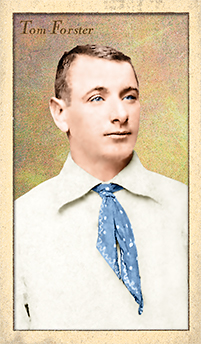
- Series: 1880s: Spotted Ties
- City: New York
- Team: Metropolitans
- League: American Association
Thomas W. Forster (1859-1946) played infield and outfield for three teams in the 1880s. His major league tenure began with the Detroit Wolverines of the National League in 1882. Tom had begun in pro ball the year before with three teams in the Eastern Championship Association: the New York Qucksteps, the New York New Yorks and the Washington Nationals, who also represented Albany, NY in '81. Following Tom's rookie season he went out to Michigan and played for the East Saginaw club in the Northwestern League. He began there again in 1884 before getting hired by the Pittsburgh Alleghenys. He got into 35 games for the team that would finish 11th in the American Association. Before the season was out, Tom was shipped back to NY and the Metropolitans. He got into only one game in '84 but saw action the next two years. Unfortunately, Forster couldn't hit in the big leagues. He was .221 in '85 and .195 in '86 with minor league stints interspersed. He ended up out “west” with Milwaukee and Davenport before returning east for final campaigns with the Hartford, CT entry in the Atlantic Association. Tom was player-manager at the end of the 1890 season.
- Forster's batting average over his four MLB seasons was .197. He had his sole HR with the Metropolitans in 1886
Auction History
Cartophilia
Old Judge Pose: 167-1
- Series: 1880s: Spotted Ties
- City: New York
- Team: Metropolitans
- League: American Association
Elmer Ellsworth Foster (1861-1946) was primarily an outfielder with the New York Metropolitans, New York Giants and Chicago Colts over a six year span beginning in 1886. The very rare baseballer who threw left and batted right, Foster achieved a career batting average of .187.
- One of the first five major leaguers born in Minnesota
- Played at Haverhill with future Hall of Famers Wilbert Robinson and Tommy McCarthy
- Noted for his speed on the base paths, Foster always had an explanation if caught stealing: “Why, I wasn’t a bit tired. Why should I have stopped running?”
Auction History
Cartophilia
Old Judge Pose: 168-1
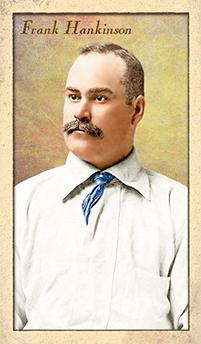
- Series: 1880s: Spotted Ties
- City: New York
- Team: Metropolitans
- League: American Association
Frank Edward Hankinson (1856-1911) was a third baseman for four early National League clubs before ending his major league tenure with two American Association teams. Just why he was, primarily, a third baseman is a bit of a head scratcher. Frank debuted with the Chicago White Stockings in 1878 and hit a respectable .267 (an average he wouldn't exceed for a decade). Manager Bob "Death to Flying Things" Ferguson did start young Hankinson on the mound one time that rookie season, a complete game loss with the pitcher surrendering six runs. Ferguson must have seen something he liked as he used Hankinson much more in '79. As the back-up to Terry Larkin, Frank went 15-10 with an ERA nearly matching the ace (2.50 vs. 2.44 for Larkin). Perhaps it was Hankinson's anemic .181 BA that made him more desirable as a pitcher but, for unknown reasons, that would be basically a one-and-done “career” as a hurler in the majors. Thereafter, Hankinson labored as a NL part-timer mostly at third, although he played all positions but catcher over his ten-year span. His move to the AA saw him get many more plate appearances, especially with the Metropolitans from 1885-87.
- Overall, Hankinson hit .228 but compiled an impressive 16-12 record on the mound, completing all his starts and throwing two shut-outs. His ERA was 2.50.
- He closed out his career with '88's last-place Kansas City Cowboys, hitting a lifetime low .174
Auction History
Cartophilia
Old Judge Pose: 211-1
- Series: 1880s: Spotted Ties
- City: New York
- Team: Metropolitans
- League: American Association
William Henry Holbert (1855-1935). Holbert was a catcher for 6 teams over 12 seasons and is perhaps best known as the player with the most career at bats without a home run (2,335). While a good defender, Bill was a weak hitter compiling a career BA of .208, with .228 OBP, .232 SLG, and an OPS+ of 47.
- One of the original umpires of the Player’s League in 1890
- Of his 486 hits, only 48 were for extra bases
Auction History
Cartophilia
Old Judge Pose: 230-1
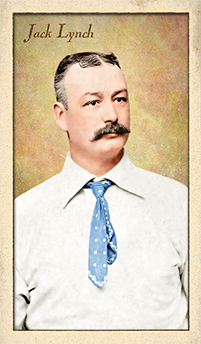
- Series: 1880s: Spotted Ties
- City: New York
- Team: Metropolitans
- League: American Association
John H. Lynch (1857-1923) was a right-hander for three New York state teams, the Buffalo Bisons, NY Metropolitans and Brooklyn Gladiators, in a career that spanned the period 1879-1890. He had several minor league assignments scattered among his total of seven major league campaigns.
While with the Metropolitans, Jack caught the attention of the New York Clipper, the weekly paper that did much to popularize baseball in its earliest days. One scribe wrote of Lynch: “Studying the in-and-out curves, rises, and drop deliveries, he rapidly acquired a reputation as an effective and puzzling pitcher . . . He has complete control of the ball, with all the curves and varying paces in delivery, and is cool and self-possessed.”
The highlight of Jack's career had to have been the championship season with the Mets in 1884. He shared the mound duties with Tim Keefe and actually nosed out the future Hall of Fame hurler in winning percentage: Lynch was 37-15 to Keefe's 37-17. Keefe had a slightly lower ERA and completed a couple more games than Lynch, but Jack had more shut-outs. All in all, they were a remarkably balanced duo who led their club to the first post-season tourney against the Providence Grays. Unfortunately, the New Yorkers were swept 3-0. Lynch would win 20+ in his two additional years with the Mets, but would never again achieve the heights of that '84 season (nor the 496 innings he threw that year).
- Jack Lynch more than held his own alternating mound assignments next to a pitching genius, widely acclaimed as one of the most dominant of the 19th century. Keefe endured but, for that one shining season in 1884, Lynch earned applause and lasting respect
Auction History
Cartophilia
Old Judge Pose: 282-1
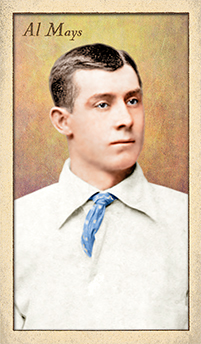
- Series: 1880s: Spotted Ties
- City: New York
- Team: Metropolitans
- League: American Association
Albert C. Mays (1865-1905) began in professional ball as a pitcher with Oil City of the Iron and Steel Association in 1884. He signed the next season with Louisville of the American Association. As the third-string hurler, Mays went 6-11 for the Colonels. He had a decent ERA of 2.76 for a sixth-place team that struggled to score runs. Mays moved to New York and the Metropolitans in '86 but continued to lose many more than he won. It was so bad in '88 that the woeful Mets (not the last time the Big Apple would bind those two words) were 44-89 with Mays providing 17 of the wins and 34 of the losses. He hurled 441 innings with a 4.73 ERA. Al's 34 defeats were the league record that year as were the 232 earned runs allowed. Thereafter, staying exclusively in the AA, Mays played for the Brooklyn Bridegrooms late in 1888 where he got to contribute to a second-place finish with a 9-9 record. He finished up with the Columbus Solons where he clearly enjoyed better run-support as he was 10-7 in 1889 with a 4.82 ERA before ending his MLB tenure the following season with but one decision, a complete-game loss.
- Mays was the only native of little Dover, Ohio to play in the big leagues. Sadly, his life ended tragically in a drowning accident at age 39 in Parkersburg, West Virginia
Auction History
Cartophilia
Old Judge Pose: 299-1
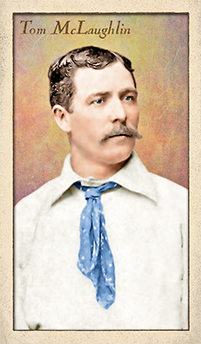
- Series: 1880s: Spotted Ties
- City: New York
- Team: Metropolitans
- League: American Association
Thomas McLaughlin (1860-1921) was primarily a shortstop for three American Association franchises beginning with the Louisville Eclipse in 1883 and finishing up with the Washington Statesmen in 1891 following a four-year hiatus from the big leagues. Never much of a hitter, Tom's career lasted as long as it did on the merits of his defensive skills. His swan song with D.C. was his best at the plate where he hit .268 - but in only 50 plate appearances.
McLaughlin's career average was a lowly .192, but his nadir came with the Metropolitans in 1886 when he hit .136 with an OPS+ of 22 (league average is 100). The underwhelming performance pushed McLaughlin back to the minors for four years. He had played much more previously for Louisville and, in his final year with what was by then the Colonels, was in every one of that 112-game campaign of 1885.
McLaughlin's '86 sojourn with the Mets earned him a place in Old Judge's “spotted tie” series that we feature here. All of which proves that lasting fame is not always the result of on-field prowess, but can also be a function of being at the right place at the right time. The same could be said of the entire Metropolitan squad of 1886, which featured ace Jack Lynch going 20-30 while the team's record was 53-82 en route to a 7th place finish where the Mets trailed 38 games behind the dominant St. Louis Browns.
- Tom's exile to the minors saw him travel from New Jersey (Newark of the International League) to Toronto, St. Paul and, finally, Syracuse to open the '91 season before his call-up to Washington.
- His personal-best hitting came with the Stars: .280, which led to his final attempt to hit big league pitching
Auction History
Cartophilia
Old Judge Pose: 316-1

- Series: 1880s: Spotted Ties
- City: New York
- Team: Metropolitans
- League: American Association
John W. Nelson (1849-1910) has a resumé reading like a history of baseball in New York: Brooklyn Eckfords (1867-69, '72) NY Mutuals ('70,) Troy Haymakers/Trojans ('72, '79,) NY Metropolitans ('83-87,) NY Giants ('87) and the Brooklyn Gladiators (1890). Candy got out of the Big Apple occasionally, playing for the Indianapolis Blues in '78 and the Worcester Ruby Legs in '81, but otherwise this native of Portland, ME was a fixture in and around the city that never sleeps.
Candy was a right-hander who batted left and was primarily a shortstop for nine franchises in three leagues over a career that saw him become the oldest player in the American Association at age 41 with the Gladiators. That finale came in a season when three major league teams graced the pastures of Brooklyn: the NL's Bridegrooms, the Players' League Ward's Wonders and Nelson's squad. He was not the only team member to hang 'em up after the 1890 campaign. Only three Gladiators continued to play professionally and none of them after July of '91. Candy was the best hitter (and only one to hit over .300) on the '83 Metropolitans as they debuted in the AA under Jim Mutrie.
- For all nickname aficionados, Baseball-Reference has determined that there have been precisely six “Candys” in the majors, with Hall of Famer Candy Cummings having the greatest renown and Candy Maldonado being the most recent.
- In 13 seasons, this Candy hit .253
Auction History
Cartophilia
Old Judge Pose: 341-1
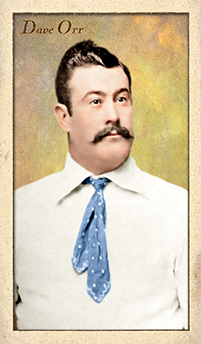
- Series: 1880s: Spotted Ties
- City: New York
- Team: Metropolitans
- League: American Association
David L. Orr (1859-1915). A 1st baseman for 5 teams over 7 major league seasons, Orr was one of the best hitters of the 1880s. Largely forgotten today, Orr may have made a case for the Hall of Fame were it not for a career-ending, paralyzing stroke suffered on the field in 1890. Dave’s .342 lifetime average is 11th all-time & in 4 of 7 seasons, his closest comp is Dan Brouthers.
Brouthers himself believed Orr was the greatest hitter of his time:
"The greatest hitter that ever played ball was old Dave Orr. He didn't care whether they were over the plate or not. If they were within reach of that long bat of his he would hit them out, and when he hit them there was no telling whether they would be found again or not. I have always held that Dave Orr was the strongest and best hitter that ever played ball." - Dan Brouthers, Sporting Life, 1894
- Won AA batting title: 1884
- Won AA RBI crown: 1884
- Lead AA in hits: 1884 & 1886
- Lead AA in triples: 1885 & 1886
Auction History
Cartophilia
Old Judge Pose: 360-1
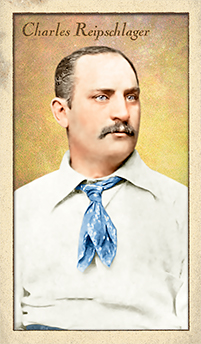
- Series: 1880s: Spotted Ties
- City: New York
- Team: Metropolitans
- League: American Association
Charles W. Reipchlager (aka Ripslager) (1856-1910) was a reserve catcher, playing the one position that didn't require an ability to hit the curve, just corral it. His major league tenure was primarily with the New York Metropolitans, beginning in 1883. He lasted four seasons as a partner with Bill Holbert, himself a light-hitting but capable receiver.
Charlie moved on to the Cleveland Blues for the '87 season where he labored in 63 games and batted .212. He would try one more time to escape the minors. He signed with the Brooklyn Gladiators for the upcoming 1890 season, only to be released before the campaign began. The Gladiators would go on to a 26-73 record that year which must have convinced Reipschlager that the majors were simply out of reach.
Reipschlager and Holbert were working behind the plate during an era of rapid change in pitching distances and pitching technique. The National League loosened the requirements for the pitching motion in 1884 but the Metropolitans' American Association didn't follow suit until mid-way through the '85 campaign. In 1886 both leagues lengthened the pitcher's “box” and placed a flat stone at the front of it to allow the umpire to police the pitcher's adherence to the defined space. The “mound” would await the 20th century's innovations.
- Reipschlager's career batting average was a meager .222, but he earned his keep in an era when short distances from the pitcher's “plate” to home made it perhaps more challenging to catch than to hit
Auction History
Cartophilia
Old Judge Pose: 386-1
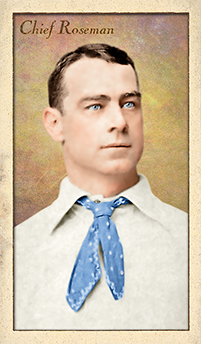
- Series: 1880s: Spotted Ties
- City: New York
- Team: Metropolitans
- League: American Association
James John Roseman (1856-1938) was born on the day America celebrated its four-score anniversary and seven years before Lincoln would use that language at Gettysburg. Brooklyn-born, Chief debuted with Brooklyn Chelsea of the League Alliance in 1877. The League was a loose consortium of clubs, the brain-child of Al Spalding as a minor league serving to prepare players for the National League which had organized the prior year. Chelsea was one of 28 teams spread from New England to Minnesota. A teammate of Roseman's was Larry Corcoran who would become one of the very few to pitch in the majors using each arm. Chief moved to two other League teams in '77, and was with several other minor league clubs before joining the Troy Trojans of the NL in 1882. He was a regular in the outfield for a team led by the great Roger Connor at first. Other luminaries on that Troy team included Buck Ewing and Tim Keefe. Roseman had been with the NY Metropolitans of the Eastern Championship Association in '81 and returned to their American Association incarnation in '83 where he would be a fixture in the outfield for five seasons. Roseman concluded his MLB career with three more AA teams, finishing with Louisville in 1890.
- Chief's career average was .263 in seven seasons. He showed some power with NY where he hit 14 of his total 17 home runs
- Played in one post-season tourney, the first, in 1884, between the NL's Providence Grays and his Mets. Roseman hit .333
Auction History
Cartophilia
Old Judge Pose: 392-1






